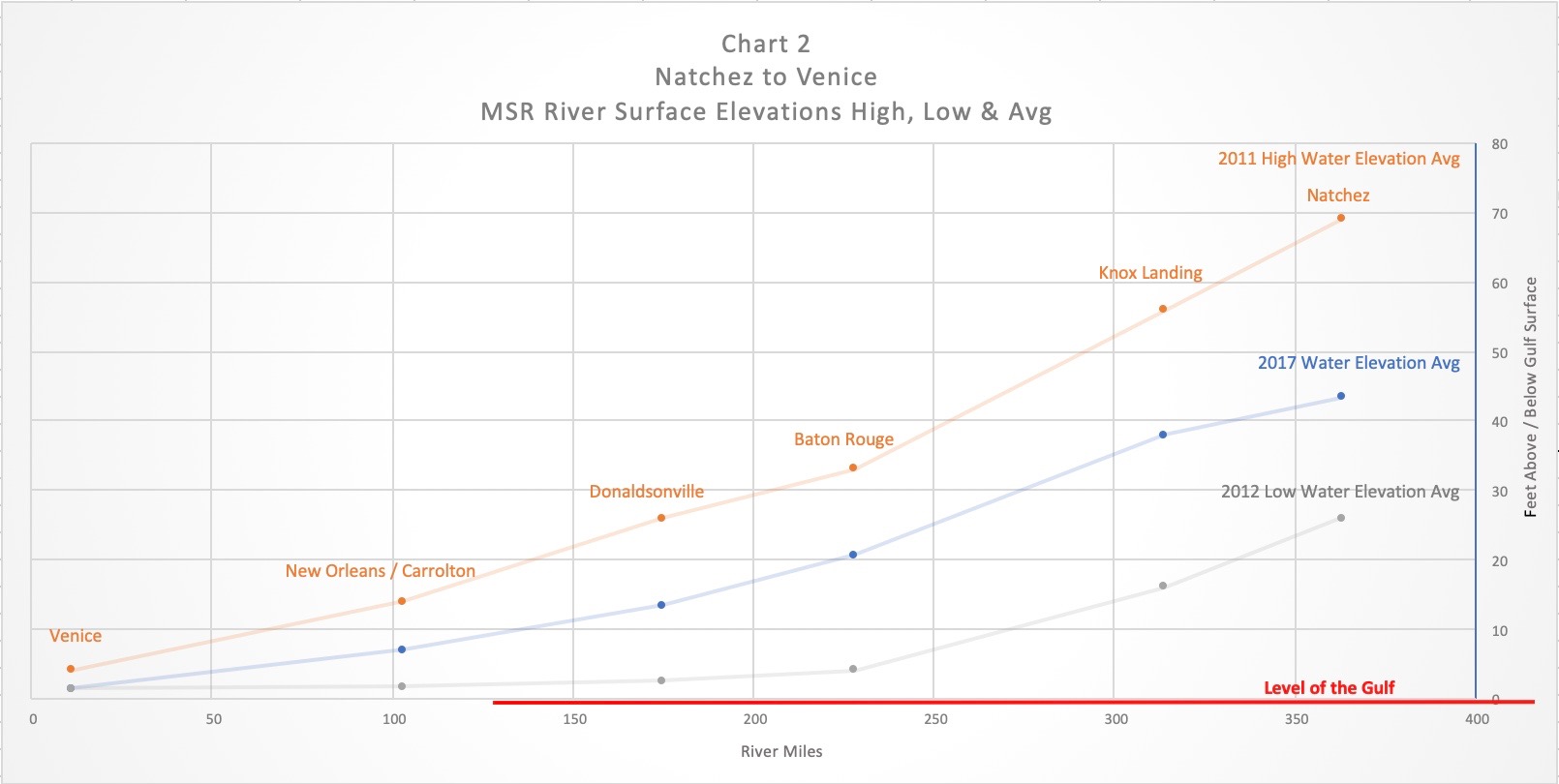
The River Stands Still
Water flows downhill. The steeper the hill, the faster the flow. The slope from Natchez to the Gulf is a quarter that from the Ohio and Mississippi Rivers’ confluence to Greenville. From New Orleans to the Gulf, the drop is less than ¾ of an inch per river mile. Thirty feet of sediment at Old River Control Structure below Natchez creates a 30-foot-high sediment plug causing water backup and massive sand bars upriver to Vicksburg. During high flow, water is several feet higher at Natchez and Vicksburg than in 1988.
Natchez is the last major gauge on the Lower Mississippi River (MSR) to measure the river whole. A few miles south, the water is split with about 23% diverted through the Old River Control Structure (ORCS) into the Atchafalaya River Basin.
The remainder flows through Baton Rouge and New Orleans and is the basis for port facilities handling billions of dollars of freight including most U.S. agricultural exports. Decisions about managing the MSR are heavily influenced by demands of maintaining deep water ports, especially from Donaldsonville to Baton Rouge.
This article and one to follow will provide details about the MSR from Natchez to the Gulf of Mexico. In later articles, we’ll explore how this reach of the MSR is influencing the Mississippi up to the Yazoo River, Greenville and beyond.
Chart 1 shows the 2017 full year average surface water elevation of the MSR from New Madrid, MO to Venice, LA — 11 miles from joining the Gulf of Mexico. Below Natchez, part of the flow is diverted into ORCS and at Venice, part of the water flows out Grand Pass. Chart 1 shows a declining slope per river mile from Memphis south and a sharp decline in slope from Natchez south.

Chart 2 is an enlarged view of the river surface elevations at different flow rates (water volumes) from Natchez to Venice. The river elevations are relative to the Mean Low Gulf (MLG) water surface.
For Natchez, water surface elevations relative to MLG, add 17 feet to the gauge reading. From Natchez to Baton Rouge, the drop per river mile is about 1 ¾ inches in normal flow. From New Orleans to Venice, the drop averages less than ¾ of an inch per river mile and even less at low water flow levels.

Potential energy, the energy of dropping from a height, is the main driver of MSR waters to the Gulf. From New Madrid, over 98% of the potential energy in the Mississippi is spent by New Orleans. By Baton Rouge, about 92% of the energy is spent and by Natchez about 83%. The reality is worse as these figures omit energy loses such as turbulence and the MSR waters descending below Gulf level in long stretches beginning just below Natchez (discussed in the next article). There is another sediment restriction as the Mississippi River joins the Gulf of Mexico.
From Natchez, the MSR is very rapidly becoming an energy depleted body unable to adjust to disturbances, which upstream would be minor. For example, the river has little ability to keep soil suspended, to scour channels or to flow past impediments such sand bars or training structures placed along the river.
The MSR from Donaldsonville (between Baton Rouge and New Orleans) to the Gulf is in many ways like the Ross Barnett Reservoir; a constant flow but only a part of the body of water going over the spillway each day. Gulf water is salty and denser than fresh water creating an energy barrier to the MSR water flowing into the Gulf. The sediment buildup near and below Venice is higher by a significant amount than the MSR river bottom, requiring part of the river waters to flow uphill, remain stagnant or gain external energy.
As Table 1 shows, 2017 is a “normal” year of the 1990-2019 period while 2011 was a high flow year and 2012 was a very low flow year. Chart 2 shows three river surface elevations (2011 – 2012) from the Table. The center line is 2017 annual average — a “normal” year. The top line of Chart 2 is the average of 6 highest months of 2011 river surface elevations. The bottom line is the average of the 6 lowest months of 2012 river surface elevations.
Table 1
Natchez Gauge
Decade Decadal Avg Gauge, Ft
1950 23.5
1960 21.5
1970 27.7
1980 26.5
1990 31.8
2000 28.7
2010 35.1
1990-2019 Average Gauge 31.9
2017 Average Annual Gauge 32.4
2011 High, Low, Average Readings 61.8 High, 16.6 Low, 35.5 Avg
2012 High, Low, Average Readings 42.6 High, 7.7 Low, 21.6 Avg
To sign up for MS River Updates from BPF, subscribe here.

Venice is much more than 11 miles from the Gulf, it is 11 miles above the Head of Passes, Southwest Pass is 20 plus miles long. I would adjust to say in this context that Venice is 30 mile above the GOM. I am not sure if the following is accurate or not, but it does not seem to be true?
“Decisions about managing the MSR are heavily influenced by demands of maintaining deep water ports, especially from Donaldsonville to Baton Rouge.” What is the reference to Donaldsonville to Baton Rouge, especially with the major port activity below Donaldsonville?